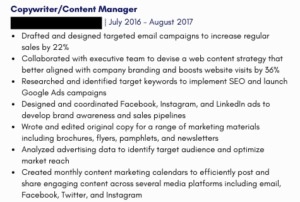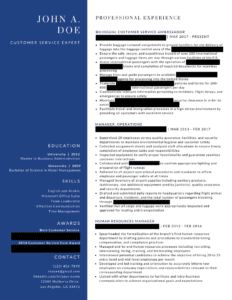Most, if not all of the jobs you will apply for will require you to submit a resume in order to be considered for the position. The purpose of the resume is to effectively highlight your strengths, differentiate you from other candidates applying for similar positions, and ultimately land you an interview.
Before you begin writing your resume, consider the positions and industries you’re interested in applying to. It is likely that you will have to create several versions of your resume in order to specifically market yourself towards certain positions or industries. For example, someone considering both private sector and public sector work, should not submit the same resume to a government customer service position and customer service position at a Fortune 500 company. Knowing what positions and industries you’d like to apply to will help you determine what strengths and skills you must highlight in your resume in order to be invited for an interview.
For the vast majority of the positions you’ll apply to, you should adhere to the one-page rule. According to a CareerBuilder study, 17% of hiring managers spend less than 30 seconds reviewing a resume. With such little time to impress the person reviewing your resume, it is imperative you do so quickly. Maintaining your resume to exactly one page and using keywords found in the employer’s job description will help push your resume into the “yes” pile.
Your resume should include the following sections: contact information, education, experience, skills, and awards. Some optional sections may include hobbies, languages, interests, publications, volunteering, and other industry-specific pieces.
What to Include in a Resume in 2019:
Contact Information: The contact information section should be the focal point of your resume. Your name should be the largest font on the resume with your phone number, email, and address provided below it. Be sure to use a professional email and avoid emails with the following domains @yahoo.com, @aol.com, and @bellsouth.net.
Education: Depending on the breadth of your experience and the relevance of your education, your education section may come after or before your experience section. If your college major is tightly related to the position you’re seeking but your experience is a bit disconnected, you should begin with your education section. If your experience better connects to the position you’re seeking, you should begin with your education section. Your education section should include your university degree, graduation month and year, and any academic honors or accolades. Your GPA should only be included if it is required by an employer or if it will portray you as an accomplished student.
Work Experience: The experience section of your resume is probably the most important section of your resume. Before writing this section conduct research on the most desired skills for the positions you’d like to apply to and review job descriptions to curate keywords you may feature on your resume in order to impress the hiring manager or recruiter. This section will outline the past work experience you’ve had and should be organized in reverse chronological order. If your most recent experience is unrelated to the position(s) you’re applying to, you should organize your experience based on their relation to the position(s) you’re seeking. When drafting each experience list the name of the company first, then your title. If your title better correlates to the title(s) of the positions you’re applying to, you should include the title first. This section of your resume should be written in bullet point format and exclude the use of pronouns (e.g. I, you, he, she). Each bullet point within this section should begin with an action verb that illustrates your responsibilities and achievements. You should use industry-specific vocabulary to demonstrate your experience. Also, consider quantifying your experience and contributions wherever possible. You can do this by describing the number of customers you assisted, providing the number of employees you managed, or dollar amount you contributed to sales for the companies you’ve worked at. Last, ensure that the action verbs describing your responsibilities at a former position are written in the past tense and that action verbs describing responsibilities at your current job are written in the present tense.

Skills and Awards: Your skills section should indicate your level of fluency in a language or experience using a variety of software systems. Be sure to list the software systems that you’ve used that are most relevant to the industries and positions you’re applying to.
Other Information: Depending on the positions you’re interested in you may include additional information like volunteering, hobbies, and publications. The hobbies/interests section could be used to humanize you as an applicant or build a connection with the hiring manager based on a common interest. You may also include any volunteer or extracurricular experience if it is related to the company’s mission or if you are applying right out of college. Last, you may include additional industry-specific achievements including publications or relevant coursework.
How to Write a Resume in 2019 & What You Should Not Include: It is unnecessary to include an objective section as your cover letter will include this information and more. You should also avoid including personal information including photographs, gender, age, and/or race. Last, refrain from including references as the employer will request this information if it is necessary.

Here is an example of a résumé that contains a headshot.
After you’ve drafted a resume, ensure all stylings and headings are consistent and use a professional font. Consider using a graphic design platform to perfectly align dates, titles, and other information included on your resume. If you’re applying to a company with a youthful or creative culture, you may add small design elements in order to really stand out.

Do you need help drafting a strong resume in order to land your dream job? Our team of career coaches and experts are ready to guide you from job search to placement.
Fill out the form below to get started.
Subscribe to our blog
Don’t miss out on the latest college admissions trends, updates, and tips!



